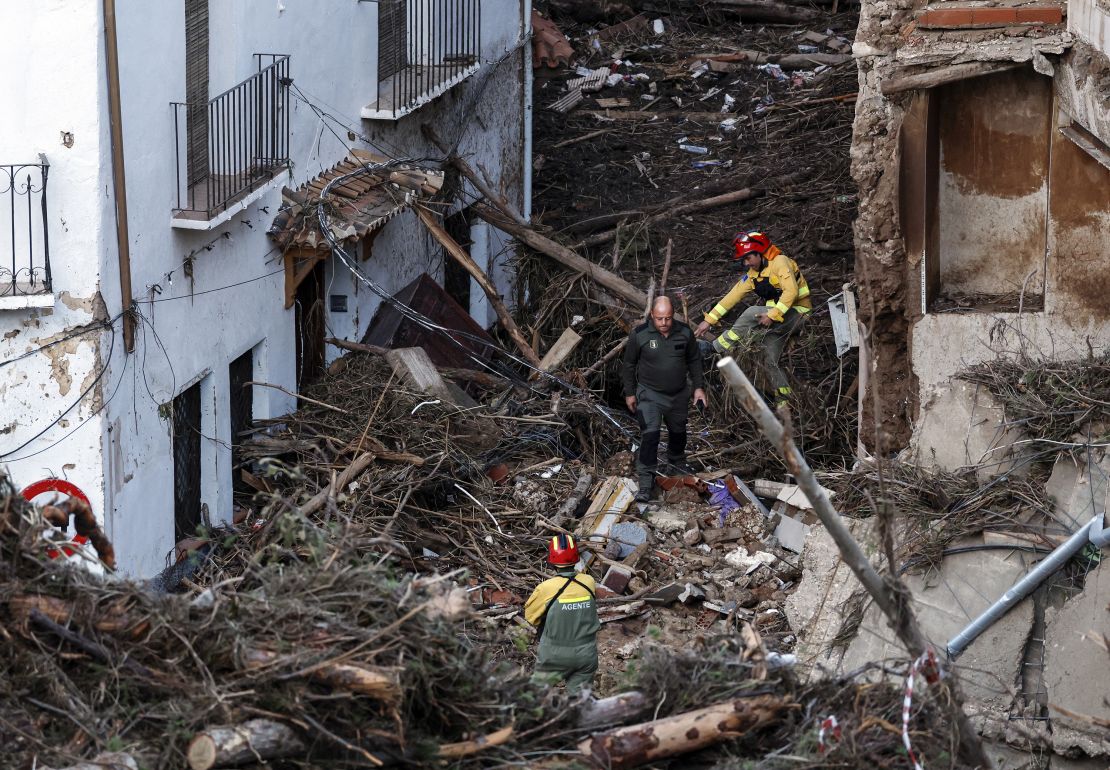CNN
—
Spain is reeling from its worst flooding in decades, after a year’s worth of rain fell in just hours this week in the country’s southern and eastern regions.
The storm began on Tuesday and has so far killed at least 95 people. It has also flooded towns and roads, caused rivers to burst their banks and left thousands without power or running water.
Valencia, the worst-struck region, saw its heaviest rainfall in 28 years with people caught off guard and trapped in basements and lower floors of buildings. Vehicles abandoned in traffic were swept away by the rising water.
Emergency workers are still fighting to rescue those who are trapped, while operations are underway to recover bodies and clear debris.
Here’s what we know.
Spain’s eastern and southern regions often see autumn rain, but this year’s downpour was unprecedented. Most of the deaths occurred in Valencia, which is located along the Mediterranean coast and is home to more than 5 million people.
The flash flooding in the region, a tourist hotspot during summer months, saw rural villages submerged in water and rendered main highways unusable on Tuesday night and into Wednesday.
A courthouse was turned into a temporary morgue in the region’s capital, the city of Valencia.

At least 40 people, six of whom were in a retirement home, died in the town of Paiporta in Valencia, Spanish state news agency EFE reported, citing its mayor.
Trains have been suspended in Valencia, as have other major public services in other affected regions. Schools, museums, and public libraries were closed into Thursday, according to the local government.
Flooding was also reported in and around the cities of Murcia and Malaga with more than 100 mm (4 inches) of rain falling in some areas. In Malaga, in the region of Andalusia on Spain’s southern coast, a 71-year-old British man died from hypothermia, the city’s mayor said.
More than 1,000 members of the military have been deployed to assist in rescue efforts, Spain’s Defense Minister Margarita Robles said. Some areas can only be reached by helicopter.
Valencia’s regional leader Carlos Mazon told reporters early Wednesday that bodies were found as rescue teams began to reach areas previously cut off by the floods. As of Thursday morning, emergency services said they had reached all the affected areas.
The Spanish government sent emergency alerts on Tuesday asking people to stay indoors or seek high ground. Extreme rain warnings were put in place for some areas including around Valencia, according to Spain’s Meteorological Agency, AEMET. These warnings called for the potential of 200 mm (8 inches) of rain in less than 12 hours.
In some locations, the rainfall estimates were exceeded in even shorter periods of time. Chiva, which is east of Valencia, received 320 mm of rain in just over four hours, according to the European Severe Weather Database. The Valencia area averages 77 mm (3 inches) for the entire month of October.
However, many people were caught off guard, leaving it too late for them to seek safety. Some took to social media to vent their frustrations, claiming that they received the emergency alert in the midst of the storm.
Hannah Cloke, a professor of hydrology at the UK’s University of Reading, said the high death toll suggests Spain’s regional emergency alerts system failed.
“It is appalling to see so many people dying in floods in Europe, when yet again weather forecasters had predicted extreme rainfall and issued warnings. The tragedy of people dying in cars and being swept away in streets is entirely avoidable if people can be kept away from rising flood water,” Cloke told CNN.
“This suggests the system for alerting people to the dangers of floods in Valencia has failed, with fatal consequences. It is clear that people just don’t know what to do when faced with a flood, or when they hear warnings.”
Spain’s Prime Minister Pedro Sanchez offered support, pledging his government would do all it could to help flood victims, as he urged people to remain vigilant. He was set to visit Valencia on Thursday.

The Spanish government has also decreed three days of official mourning, starting on Thursday.
Thousands in Valencia’s suburbs are still without power and running water on Thursday. Search operations and debris clearing continues.
The Spanish Securities and Emergencies department has issued weather warnings for many regions. Orange and yellow alerts remained in place in isolated parts of Valencia, while rain continues in Castellon, a province to the north.
Extreme weather warnings continue for portions of eastern and southern Spain, according to AEMET, with more rain expected.
The torrential rain was likely caused by what Spanish meteorologists call a “gota fría,” or cold drop, which refers to a pool of cooler air high in the atmosphere that can separate from the jet stream, causing it to move slowly and often lead to high-impact rainfall. This phenomenon is most common in autumn.
Figuring out the precise role climate change played in Spain’s devastating floods will require further analysis, but scientists are clear that global warming, driven by fossil fuel pollution, makes these types of extreme rainfall events more likely and more intense.
Hotter oceans fuel stronger storms and the Mediterranean hit its highest temperature on record in August. Warmer air is also able to hold more moisture, soaking it up like a sponge to wring out in the form of torrential rain.
“We can’t say anything on the fly,” said Ernesto Rodríguez Camino, senior state meteorologist and a member of the Spanish Meteorological Association. He added though that “in the context of climate change, these types of intense and exceptional rare rainfall events are going to become more frequent and more intense and, therefore, destructive.”